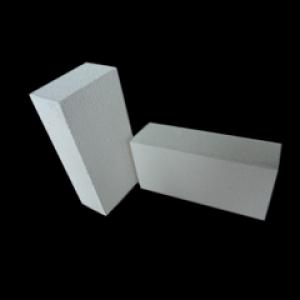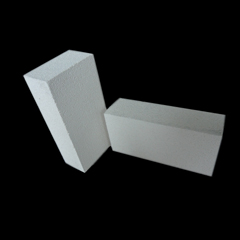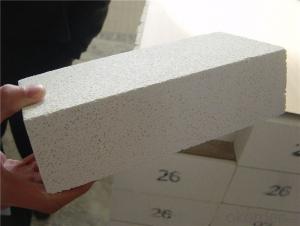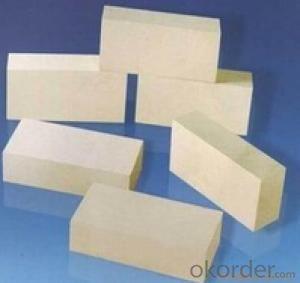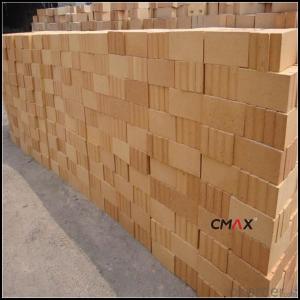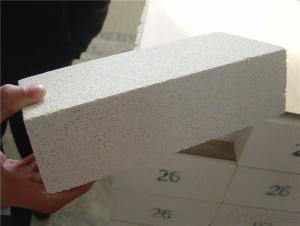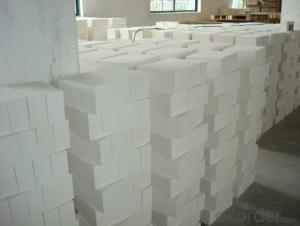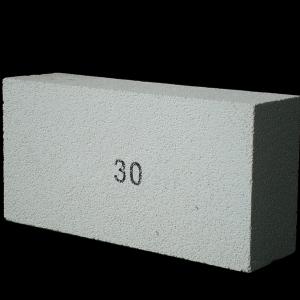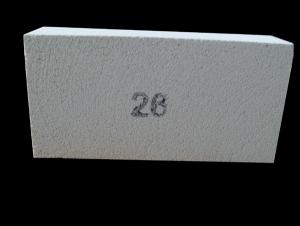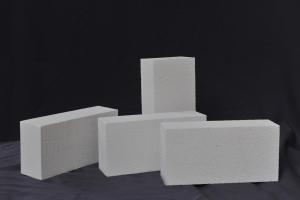Insulating Fire Brick - Insultaing Fire Brick
- Loading Port:
- China Main Port
- Payment Terms:
- TT OR LC
- Min Order Qty:
- -
- Supply Capability:
- -
OKorder Service Pledge
Quality Product, Order Online Tracking, Timely Delivery
OKorder Financial Service
Credit Rating, Credit Services, Credit Purchasing
You Might Also Like
General Information
CMAX insulating firebricks are classified under temperature between 1300℃ to 1700℃, manufactured from high purity alumina clay.
Feature
Light weight and low thermal conductivity
Low heat storage
Low iron and impurities
High thermal shock resistance
Application
CMAX insulating firebricks can be used as a hot face lining directly exposed to the heat or as a backup insulation layer in iron and steel mills, non-ferrous foundries, petrochemical, ceramic, glass.
- Q: Are insulating fire bricks resistant to thermal fatigue?
- Insulating fire bricks are indeed resistant to thermal fatigue. These bricks are specifically designed to withstand high temperatures and thermal cycling without cracking or breaking. They are made from refractory materials that have excellent thermal shock resistance, allowing them to expand and contract without any significant damage. This resistance to thermal fatigue makes insulating fire bricks ideal for applications that involve extreme temperature variations, such as in kilns, furnaces, and other high-temperature environments.
- Q: Do insulating fire bricks require preheating before use?
- Insulating fire bricks typically need to be preheated prior to use for several reasons. Firstly, preheating helps eliminate any moisture or volatile organic compounds that may be present in the bricks. This is crucial as the presence of moisture or volatile compounds can lead to cracking or even explosions when the bricks are exposed to high temperatures. Additionally, preheating allows the bricks to be conditioned and prevents thermal shock, which can occur when the bricks are rapidly exposed to extreme temperatures. By gradually increasing the temperature, the bricks are able to expand and contract without sustaining any damage. Therefore, it is highly recommended to preheat insulating fire bricks before using them to ensure their durability and optimal performance.
- Q: Can insulating fire bricks be used in the construction of tundishes?
- Yes, insulating fire bricks can be used in the construction of tundishes. Tundishes are commonly used in the steel industry to distribute molten metal, and insulating fire bricks are ideal for this purpose as they have excellent thermal insulation properties and can withstand high temperatures.
- Q: Do insulating fire bricks have a high fireproof rating?
- Insulating fire bricks indeed have a high fireproof rating. These bricks are specifically designed to withstand extremely high temperatures and provide excellent insulation against heat transfer. They are made from special refractory materials that have low thermal conductivity, which helps in retaining heat and preventing it from escaping the system. Insulating fire bricks can withstand temperatures ranging from 2300°F to 3100°F (1260°C to 1700°C), making them ideal for use in furnaces, kilns, fireplaces, and other high-temperature applications. Their high fireproof rating ensures that they can effectively protect structures and equipment from the intense heat and flames, allowing for safe and efficient operation in various industries.
- Q: Can insulating fire bricks be used in refractory lining applications?
- Yes, insulating fire bricks can be used in refractory lining applications. Insulating fire bricks are made from lightweight materials that have high insulating properties, such as clay or silica. These bricks are designed to provide excellent thermal insulation, reducing heat loss and improving energy efficiency in high-temperature applications. In refractory lining applications, insulating fire bricks are commonly used to line the walls, floors, and roofs of furnaces, boilers, kilns, and other industrial equipment. They are effective in preventing heat transfer to the surrounding environment and maintaining the desired temperature inside the equipment. Insulating fire bricks are also resistant to thermal shock, meaning they can withstand rapid changes in temperature without cracking or failing. This makes them suitable for applications where the equipment goes through frequent heating and cooling cycles. Furthermore, insulating fire bricks have low thermal conductivity, which means they can effectively limit heat transfer between different areas of the refractory lining. This helps to prevent hot spots and temperature imbalances, ensuring uniform heat distribution throughout the equipment. Overall, insulating fire bricks are a versatile and effective choice for refractory lining applications, providing excellent thermal insulation, resistance to thermal shock, and uniform heat distribution.
- Q: Can insulating fire bricks be used in fireplace construction?
- Indeed, fireplace construction can make use of insulating fire bricks. These bricks are specifically crafted to endure extreme temperatures and offer exceptional insulation, rendering them appropriate for lining fireplaces. By retaining heat and impeding heat transfer to the surrounding structure, they enhance the fireplace's efficiency while diminishing the likelihood of harm to adjacent materials. Moreover, the lightweight and manageable nature of insulating fire bricks make them an excellent choice for constructing fireplaces.
- Q: Are insulating fire bricks suitable for use in aluminum smelting furnaces?
- Insulating fire bricks are typically unsuitable for aluminum smelting furnaces as they are designed to retain heat rather than withstand extreme temperatures. Aluminum smelting requires temperatures exceeding 1,000 degrees Celsius, making refractory fire bricks or refractory castables more appropriate. These materials have high melting points and can endure the intense heat without compromising their structural integrity. They also possess excellent thermal shock resistance, which is crucial due to rapid temperature fluctuations in the furnace during operation. Furthermore, refractory materials used in aluminum smelting furnaces should exhibit resistance to corrosion and chemical attack from molten aluminum and other substances involved in the smelting process. Insulating fire bricks may lack the necessary chemical resilience, potentially resulting in premature degradation and failure of the furnace lining. In conclusion, although insulating fire bricks may be suitable for applications requiring thermal insulation, they are generally not recommended for use in aluminum smelting furnaces. Refractory fire bricks or refractory castables are better suited for this chemically aggressive and high-temperature environment.
- Q: Can insulating fire bricks be used for insulation in foundries?
- Yes, insulating fire bricks can be used for insulation in foundries. Insulating fire bricks are specifically designed to have high thermal resistance and low thermal conductivity, making them ideal for applications where insulation is required. In foundries, where high temperatures are involved, insulating fire bricks can be used to line the walls, floors, and roofs to reduce heat loss and improve energy efficiency. They can also help to maintain a uniform temperature throughout the foundry, ensuring consistent heat distribution and preventing heat loss to the surroundings. Additionally, insulating fire bricks are lightweight and easy to install, making them a practical choice for insulation in foundries.
- Q: Can insulating fire bricks be used for insulation in autoclaves?
- Insulating fire bricks have the capability to be utilized for insulation within autoclaves. These bricks are specifically engineered to possess a minimal thermal conductivity, enabling them to proficiently retain heat and endure elevated temperatures. The insulation of autoclaves necessitates the ability to sustain a steady temperature and pressure, and insulating fire bricks excel in delivering exceptional insulation properties amidst these challenging circumstances. Furthermore, their robustness and durability render them well-suited for enduring the rigorous heat and pressure fluctuations commonly encountered in autoclaves. All in all, insulating fire bricks emerge as a dependable and efficient option for insulating autoclaves.
- Q: What is the typical open porosity of an insulating fire brick?
- The open porosity of insulating fire bricks can vary depending on the specific type and manufacturer. On average, these bricks have an open porosity ranging from 45% to 70%, meaning that around 45% to 70% of their volume consists of interconnected voids or pores. This characteristic is crucial for their thermal insulation properties. The brick's insulating capabilities improve with higher open porosity since the voids serve as barriers to heat transfer. However, insulating fire bricks with lower open porosity tend to be denser and more durable, although their thermal insulation properties may be reduced.
Send your message to us
Insulating Fire Brick - Insultaing Fire Brick
- Loading Port:
- China Main Port
- Payment Terms:
- TT OR LC
- Min Order Qty:
- -
- Supply Capability:
- -
OKorder Service Pledge
Quality Product, Order Online Tracking, Timely Delivery
OKorder Financial Service
Credit Rating, Credit Services, Credit Purchasing
Similar products
Hot products
Hot Searches
Related keywords
